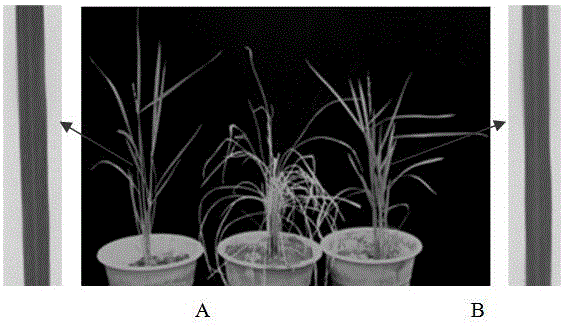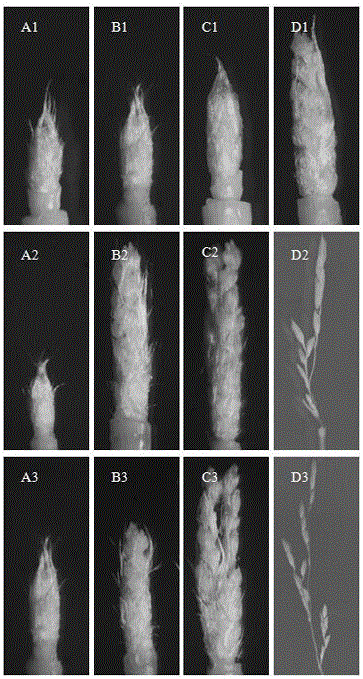Vector with double expression cassettes and high glyphosate resistance and application thereof to rice
A glyphosate-resistant and plant expression vector technology is applied in the application field of cultivating glyphosate-resistant rice, and can solve the problems of affecting yield, affecting the normal differentiation of young ears of rice, reducing rice yield, and the like, and achieving the effect of ensuring yield
- Summary
- Abstract
- Description
- Claims
- Application Information
AI Technical Summary
Problems solved by technology
Method used
Image
Examples
Embodiment 1
[0019] Example 1 Double expression cassette glyphosate-resistant plant expression vector
[0020] 1. Rfl promoter cloning: Rice genomic DNA was extracted by CTAB method. Search rice Rfl gene sequence from NCBI database, intercept 2000 bp upstream of the start codon of Rfl gene as promoter region, design primers: F: 5'-TACAAAAATTTCGACTAAACTCG-3', R: 5'-TTTATCGTCATCATGGCCACCGC-3' clone Promoter, obtain a fragment with a length of 2001bp. The fragment was recovered and purified, and polyA tailed after sequencing.
[0021] 2. Construction of High Efficiency Specific Plant Expression Vector with Double Expression Cassettes
[0022] (1) Excise the Ubi promoter in PUEP (pCAMBIA1300-Ubi-epspsM-Tnos).
[0023] (2) Ligate the Rfl promoter fragment to the above-mentioned PUEP backbone without the Ubi promoter, and partially cut it with HindIII+EcoRV double enzymes for 5 minutes to obtain the Rfl-Osctp-epspsM-Tnos expression cassette fragment.
[0024] (3) Digest the pCDMAR-Hyg vect...
Embodiment 2
[0027] Example 2: Transformation of pCDMAR-Ubi-Osctp-OsEpspsM-Tnos-Rfl-Osctp-OsEpspsM rice material to obtain
[0028] Using the Agrobacterium-mediated method to obtain transgenic pCDMAR-Ubi-Osctp-OsEpspsM-Tnos-Rfl-Osctp-OsEpspsM rice, the specific steps are as follows:
[0029] 1. Induction and subculture of embryogenic callus
[0030] Take the immature ears of rice 15-20 days after pollination, soak them in 75% ethanol for 1 min after shelling, then transfer them to 25wt.% sodium hypochlorite solution for vibration sterilization for 25 min, and wash them in sterile water on a clean bench for 3-5 times , Pick out the immature embryos of the sterilized seeds and inoculate them in the induction medium, about 30 grains per dish, culture them in the dark at 28°C for 7 days, remove the radicle, continue to culture them for 7 days, and subculture after the callus grows up. Appropriate embryogenic calli can be selected for Agrobacterium transformation from the third generation onw...
Embodiment 3
[0043] Example 3 Molecular detection of rice materials transformed with pCDMAR-Ubi-Osctp-OsEpspsM-Tnos-Rfl-Osctp-OsEpspsM
[0044] 1. Extract the total DNA of transgenic rice and non-transgenic rice leaves, and design specific primers according to the gene sequence, F: 5'-GAAAAAGCCTGAACTCACCGC-3', R: 5'-TGCTCCATACAAGCCAACCAC- 3'
[0045] Perform PCR amplification detection, and screen the positive strains whose PCR amplified fragment size is consistent with the expected size for further molecular detection.
[0046] 2. Enzyme PCR reaction system
[0047] Template 1μg
[0048] Primer1 (5μM) 1μL
[0049] Primer2 (5μM) 1μL
[0050] Golden DNA Polymerase 0.4μL
[0051] 2×Reaction Mix 12.5μL
[0052] ddH2O 9.1μL
[0053] 3. PCR reaction program:
[0054] 94°C for 5 minutes; {94°C 45s / 90s, 60°C / 65°C / 56°C (set the annealing temperature according to the primer) 30s / 60s, 72°C 45s / 90s (determine the extension temperature according to the length of the amplified fragment)} 35 c...
PUM
 Login to View More
Login to View More Abstract
Description
Claims
Application Information
 Login to View More
Login to View More - R&D
- Intellectual Property
- Life Sciences
- Materials
- Tech Scout
- Unparalleled Data Quality
- Higher Quality Content
- 60% Fewer Hallucinations
Browse by: Latest US Patents, China's latest patents, Technical Efficacy Thesaurus, Application Domain, Technology Topic, Popular Technical Reports.
© 2025 PatSnap. All rights reserved.Legal|Privacy policy|Modern Slavery Act Transparency Statement|Sitemap|About US| Contact US: help@patsnap.com



